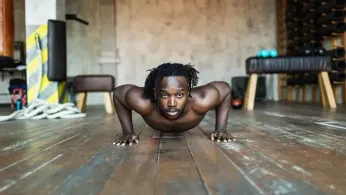
4 hours ago
Queer Gym Culture 2.0: Stronger, Softer, and Unapologetically Ours
READ TIME: 3 MIN.
Step into a queer-affirming gym in 2025 and you’ll notice something has shifted. No more side-eye at the squat rack, no more “Are you sure you belong here?” glances in the locker room. Instead, there’s laughter, a playlist blasting queer anthems, and trainers who know their way around a pronoun pin as well as a kettlebell. Queer gym culture has undergone a seismic transformation—one that’s less about perfecting your body for someone else’s gaze and more about claiming joyful movement as a deeply personal, radical act of self-love .
For decades, the “mainstream” gym experience has been fraught for LGBTQ+ folks. Gendered locker rooms, rigid expectations of what “fitness” looks like, and a culture obsessed with thinness or hyper-masculinity didn’t just feel unwelcoming—they reinforced the very ideals many of us had spent years trying to unlearn. Transgender and non-binary people, in particular, have long faced a minefield of microaggressions, dysphoria triggers, and outright exclusion, often making traditional gyms a source of anxiety rather than empowerment .
But change is here—and it’s grassroots. Across North America, a new crop of queer-owned and queer-affirming fitness studios are rewriting the script. These spaces—from Minneapolis’s Soulcana to Oakland’s Queer Gym—are prioritizing respect, joy, and mental resilience over the outdated dogma of “no pain, no gain” .
What does the new wave of queer gyms actually look and feel like? Picture this: gender-neutral changing rooms, trainers fluent in the language of consent and affirmation, and classes as varied as the community itself—from “Trans Strength 101” to fat-positive dance sessions and queer yoga flows .
Take OutBox Gym, a queer- and trans-centered boxing and fitness studio in Southern California, where founder Priscilla Collings describes the mission as “bending barbells and beating mediocrity.” OutBox specializes in boxing, kickboxing, and personal training—all with a focus on community, safety, and empowering people to “move with mindful joy” .
Meanwhile, Ascent in Tacoma touts itself as an “anti-diet, fat-positive space that rejects harmful weight stigma and promotes body acceptance,” creating a fun atmosphere where fitness becomes a celebration, not a punishment .
Soulcana Fitness in Minneapolis, founded by a queer woman, is all about fostering self-acceptance and community. “We’re here to celebrate every body, every journey,” says a member, “and the only thing we measure is how much you love yourself when you walk out the door” .
It’s not just brick-and-mortar gyms evolving. The digital revolution has hit the queer fitness world with a rainbow-hued vengeance. Virtual reality (VR) fitness environments—like QueerSpace Fitness VR, Rainbow Studios VR, and TransFit Virtual—are creating spaces where our bodies are never policed, and harassment is kept out by AI-powered moderators .
Queer users are flocking to these platforms: engagement with VR fitness platforms has jumped 400% among LGBTQ+ people this year, and body-positive apps are seeing retention rates that far outstrip traditional fitness tech . Users can customize avatars to reflect their bodies and gender expressions, ensuring that the virtual space is as affirming as the physical one. As Alex Chen, a TransFit Virtual beta tester, puts it: “VR fitness has given me the safe space I never had in traditional gyms. I can be myself, work on my fitness goals, and connect with a community that truly understands my journey” .
Perhaps the most radical shift in queer gym culture is the decentering of aesthetics in favor of holistic health. The new mantra? Fitness is for every body, and mental health matters as much—if not more—than muscle mass. Many queer gyms offer workshops on self-acceptance, body neutrality, and resilience, blending movement with mental wellness .
Trainers at inclusive gyms recognize that for trans and queer members, exercise can affirm gender identity, help manage dysphoria, and promote self-confidence. Strength training is reframed not as a path to “passing” or fitting in, but as a tool for empowerment and self-alignment. “Fitness isn’t about becoming someone else,” one OutBox member shares. “It’s about fully inhabiting the body you have—and loving it fiercely” .
As more gyms embrace gender-neutral policies, diverse programming, and staff who reflect the communities they serve, the queer fitness revolution is only gaining steam. The days of toxic gym culture—rife with body policing and exclusion—are numbered. In their place, we’re building sanctuaries where strength is measured in connection, tenderness, and the freedom to move as your truest self .
Whether you’re stepping into a boxing ring, logging into a VR workout, or just stretching out in a sunlit studio that finally feels like home, one thing is clear: queer gym culture 2.0 is here. And it’s strong, soft, and unapologetically ours.






